Dwividha bheda of Jwara
0 likes347 views
This presentation deals with dwidha types of Jwara
1 of 12
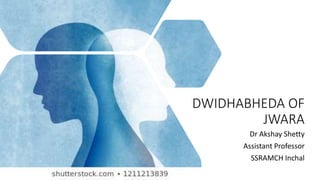

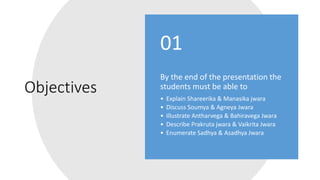
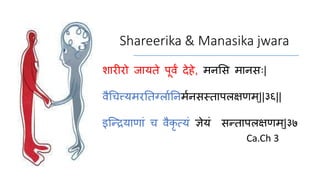
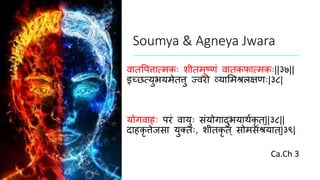


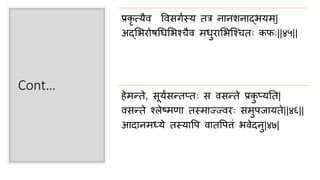
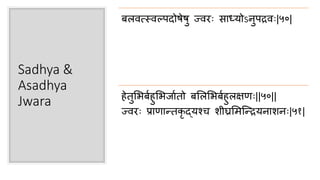
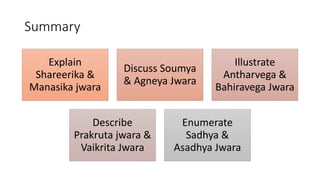


Ad
Recommended
Sapta Dhatugata jwara
Sapta Dhatugata jwaraAkshay Shetty
Ã˝
This presentation deals with Lakshana and Sadhyasadhyata of Dhatugata JwaraShilajatu.pptx
Shilajatu.pptxSaranya Sasi
Ã˝
This document provides information on Shilajatu, including:
1) It introduces Shilajatu as the 5th mineral drug in the Maharasa group and discusses its various names in Sanskrit, Hindi, English and Latin.
2) It describes the sources, classification, occurrence, mineralogical identification and composition of Shilajatu.
3) It discusses the history, types, properties and grahya swarupa (identifying features) of Shilajatu according to ancient Ayurvedic texts.
4) It explains that Shilajatu needs shodhana (purification) before use to avoid side effects, and provides details on the shodPANCHA SHWASA PRESENTATION Dr Akshay Shetty.pptx
PANCHA SHWASA PRESENTATION Dr Akshay Shetty.pptxAkshay Shetty
Ã˝
The document presents an overview of Pancha Shwasa, including its objectives, cardinal features, dosha predominance, distinctions among different types, and correlations with modern medical understanding. It describes various conditions such as Mahashwasa, Urdhwa Shwasa, Chinna Shwasa, Kshudra Shwasa, and Tamaka Shwasa, detailing their symptoms and prognoses. The presentation concludes with references to classical texts.Abhraka.pptx
Abhraka.pptxSaranya Sasi
Ã˝
Abhraka is a type of mica that is classified as a maharasa in Ayurveda. It has several therapeutic properties and is used in processing mercury and in medicines. There are different types of Abhraka based on factors like color, texture, and heat response. High quality Abhraka is obtained from the Himalayan mountain regions and has the best therapeutic effects. Proper processing like heating and washing is required to remove impurities from Abhraka and ensure it is free from toxins.Introduction of kaumarbhritya
Introduction of kaumarbhritya dobariyamiral
Ã˝
1. Kaumarbhritya is the 6th branch of Charak Samhita and 5th branch of Sushrut Samhita, dealing with pediatric care. It focuses on antenatal, neonatal care and treatment of childhood diseases.
2. Pediatricians face many challenges as children's tissues are not fully developed, they cannot communicate well and require modified doses and procedures compared to adults.
3. The prenatal, postnatal and different pediatric age groups like newborn, infant, toddler etc. are defined based on gestational age and chronological age. Birth weight, preterm, term categories are also defined.basti
basti Saurav Verma
Ã˝
This document discusses the role of Basti therapy in promoting health, preventing disease, and treating disease according to Ayurveda. It begins by introducing the two approaches of preventive and curative management in Ayurveda. It then explains how Basti therapy is superior to other Panchakarma treatments and can have the effects of the other treatments. The document outlines specific Basti therapies and herbal formulations that can be used for health promotion, disease prevention, and treatment of various diseases like Jwara, Atisara, and Pravahika according to Charaka, Sushruta, and Vagbhata.Shwasakuthara ras,Tribhuvana kirti Ras,Hinguleswara Ras.pptx
Shwasakuthara ras,Tribhuvana kirti Ras,Hinguleswara Ras.pptxSrikanth Vuyyuru
Ã˝
The document provides an in-depth analysis of various ayurvedic formulations, particularly focusing on shwasakuthara rasa and hinguleswara rasa for treating respiratory disorders and fevers. It details the ingredients, their properties, preparation methods, dosages, and therapeutic uses based on classical texts. Additionally, it highlights the unique preparations and pharmacological actions of these formulations in Traditional Indian Medicine.Vyadhikshmatva.pptx 1.pptx
Vyadhikshmatva.pptx 1.pptxAkshay Shetty
Ã˝
The document discusses 'Vyadhikshmatva', a concept in Ayurveda related to the body's strength and immunity against disease manifestation. It outlines the definitions, types of 'Bala' (strength), and the relationship between immunity and health, emphasizing the role of 'Satmya' (suitability) in maintaining wellness and preventing disease. The presentation aims to educate students about the mechanisms of disease prevention and the factors influencing an individual's strength and health.Makshika.pptx
Makshika.pptxSaranya Sasi
Ã˝
This document discusses the mineral Makshika (Chalcopyrite). It provides the Sanskrit, Hindi, and English names. It details the chemical formula and properties such as color, crystals, fracture, and hardness. It describes the occurrence in India and types based on color. Purification and processing methods are explained, including heating with oils and crushing. The therapeutic uses and formulations using Makshika bhasma are mentioned. Rajata Makshika (Iron Pyrite) is also briefly discussed.Kamala Roga
Kamala RogaAkshay Shetty
Ã˝
This document discusses Kamala roga (jaundice), including its etymology, classification, causes, pathogenesis, symptoms, and prognosis. Kamala roga is classified into four types - Koshta Shakashrita (intestinal obstruction-related), Shakashrita (channel-related), Kumbha (chronic), and Halimaka. The document explains the causes, pathogenesis, and symptoms of each type in detail. It also states that jaundice becomes life-threatening at an advanced stage if the symptoms include black stool, yellow urine, edema, red eyes/face, and loss of appetite and consciousness. References included Charaka Samhita, Sushruta Samhita, andPARIBHASHA OF RASASHASTRA BY DR AJITH KUMAR
PARIBHASHA OF RASASHASTRA BY DR AJITH KUMARDR AJITH KUMAR
Ã˝
The document discusses the importance of technical terminology or paribhasha in Rasashastra (Ayurvedic alchemy). It provides definitions and examples of important terms used in purification techniques like Shodhana. Shodhana aims to remove impurities from materials using various processing methods such as Mardhana, Bhavana, Swedana and is a crucial first step in Rasashastra.Kamala - An Ayurvedic View
Kamala - An Ayurvedic ViewSachin Bagali
Ã˝
Kamala, known as jaundice in modern terms, is an Ayurvedic liver disorder characterized by yellow discoloration of the skin, eyes and mucous membranes. It is caused by an accumulation of pitta dosha in the liver or bile ducts. There are two main types - Kosthashrita Kamala caused by pitta accumulating in the liver, and Shakhashrita Kamala or obstructive jaundice caused by pitta accumulating in the bile ducts. Treatment focuses on eliminating excess pitta through mild purgation and a pitta-pacifying diet and medications.STHANANTHARAGATI PPT.Final year.pptx
STHANANTHARAGATI PPT.Final year.pptxDrMalathiVenketesham
Ã˝
This document discusses the concept of Avarana or obstruction in Ayurveda. It begins by defining Avarana as the covering or encircling of Vata dosha, which can produce disease. It then classifies Avarana into two main types - Paraspara Avarana involving obstruction of one Vata by another Vata, and Anya Avarana involving obstruction of Vata by other doshas, dhatus, or malas. Numerous sub-types of Anya Avarana are outlined along with their characteristic symptoms and recommended treatments. The document also discusses upadravas or complications that can arise from neglected Avarana.Medhya rasayan
Medhya rasayanvidhu mahehswari
Ã˝
The document discusses Medhya Rasayana in Ayurveda. It defines Medhya Rasayana as substances or activities that promote mental competence. It classifies and describes various Medhya drugs mentioned in Charak Samhita, Sushrut Samhita, Astang Hridya and Astang Sangraha. The document explains how Ushnavirya and Sheeta Virya drugs work to improve memory, retention and other cognitive functions. It concludes with some research studies conducted on Medhya Rasayan.Shwitra
Shwitra Akshay Shetty
Ã˝
1. The document is a presentation on Shwitra (vitiligo) by Dr. Akshay Shetty that defines the condition and discusses its synonyms, causes, types, symptoms, and treatability.
2. It classifies Shwitra into three types based on dosha involvement and stage of the disease. Symptoms vary in color depending on the dhatu affected.
3. Shwitra with coalesced patches, red hair above patches, or a duration over one year are considered not curable, while those with pale thin skin and elevated patches between less than one year may be treatable.Vata-Rakta vyadhi nidana
Vata-Rakta vyadhi nidana Jay Gondaliya
Ã˝
Vatarakta, or gout, is a joint disease characterized by painful inflammation, mainly affecting smaller joints, and results from an imbalance of doshas, primarily vata, in conjunction with rakta dhatu. Its onset is attributed to dietary habits and lifestyle choices, leading to an increase in vata dosha that adversely affects the rakta dhatu, causing various symptoms such as pain, swelling, and discoloration. The condition can be classified based on dosha and severity into curable, manageable, or incurable forms, depending on the involvement of single or multiple doshas and associated complications.Pandu Roga
Pandu RogaAkshay Shetty
Ã˝
The document discusses 'Pandu Roga', a health condition, detailing its etymology, definition, classifications, and symptoms. The presentation outlines objectives for learners to understand various aspects of Pandu Roga, including its causes, progression, and the conditions associated with it. It also includes references to classical texts and emphasizes the importance of lifestyle factors in the condition's development.Nidana panchaka by Dr.Swatika
Nidana panchaka by Dr.SwatikaDr.Swatika Sharma
Ã˝
This document discusses the Ayurvedic concept of nidana, which refers to both the diagnosis of a disease and its etiological factors. It defines nidana as that which gives complete knowledge about a disease. It describes the different types of hetu (causative factors) according to their proximity (sannikrsta and viprakrsta) and strength (pradhanika). It also discusses the various ayatanas or sites of pathogenesis, including improper conjunction of the senses and their objects. Overall, the document provides an overview of the key Ayurvedic principles for understanding disease causation and pathogenesis.Vaikranta.pptx
Vaikranta.pptxSaranya Sasi
Ã˝
This document discusses the mineral vaikranta (tourmaline). It provides details on its chemical formula, sources, color variations, purification process involving swedana and kulattha kashaya, and marana process using gandhaka and nimbu. Vaikranta bhasma has therapeutic uses for diseases like pandu, udara, and prameha. Its uses are described in classical texts like the Ashtanga Hridaya. Precautions are mentioned for use of impure vaikranta which can cause diseases. Common formulations containing vaikranta are also listed.Introduction of Vyadhi.pptx
Introduction of Vyadhi.pptxAkshay Shetty
Ã˝
The document provides an introduction to the Ayurvedic concept of Vyadhi (disease). It discusses the etymology and definitions of Vyadhi, as well as synonyms. Various classifications of Vyadhi are described based on factors like prognosis, intensity, location, causes, and site of origin. Single-fold, two-fold, and three-fold classifications are presented, differentiating types of Vyadhi according to these factors. The document serves as an overview of the fundamental Ayurvedic understanding of the nature and categories of disease.Introduction to jwara
Introduction to jwaraAkshay Shetty
Ã˝
The document discusses jwara (fever) according to Ayurveda. It defines jwara, lists its synonyms, and explains its importance. It describes the pathogenesis of jwara, originating from improper diet and lifestyle, and traveling through the channels to manifest symptoms. Early symptoms, full development, and general signs of jwara are provided. Key sources like Charaka Samhita are referenced to support the descriptions.Asthanindita purusha.pptx
Asthanindita purusha.pptxAkshay Shetty
Ã˝
The document discusses asthanindita purusha (types of physical abnormalities in Ayurveda), outlining eight categories such as dwarfism, gigantism, and obesity, and their associated health risks. It highlights the correlation of these conditions with hormonal and endocrine disorders, emphasizing the difficulties in treatment and potential complications. The text aims to educate students on the clinical features and importance of understanding these physical variations in a medical context.Samsarjana krama .pptx
Samsarjana krama .pptxAkshay Shetty
Ã˝
The document discusses Samsarjana Krama, which refers to the gradual process of restoring normal metabolic functions after purification therapies like vomiting or purgation. It classifies Samsarjana Krama based on the quantity of doshas eliminated, and outlines the different dietary items consumed in sequence - including peya (thin gruel), vilepi (thick gruel), yusha (meat broth), and mamsa rasa (meat soup). The document explains the nutritional properties and indications for each item in Samsarjana Krama.Nidanarthakara Roga.pptx
Nidanarthakara Roga.pptxAkshay Shetty
Ã˝
Nidanarthakara roga refers to diseases that act as causes for other diseases. They are classified as ekarathakari or ubhayarthakari. Examples provided are jwara causing raktapitta or vice versa. Vyadhi sankara means a group of diseases where one disease can lead to others or they share common causes or symptoms. Improper treatment or one disease being the cause of another can result in vyadhi sankara situations. Mutrakricchra (Dr Akshay Shetty)ppt .pptx
Mutrakricchra (Dr Akshay Shetty)ppt .pptxAkshay Shetty
Ã˝
This document deals with cardinal symptom ,etiopathogenesis classification and symptoms of Mutrakricchra Atisara (Ayurveda) Dr Akshay Shetty.pptx
Atisara (Ayurveda) Dr Akshay Shetty.pptxAkshay Shetty
Ã˝
This presentation highlights cardinal symptom ,etiopathogenesis clinical features and prognosis of AtisaraMore Related Content
What's hot (20)
Vyadhikshmatva.pptx 1.pptx
Vyadhikshmatva.pptx 1.pptxAkshay Shetty
Ã˝
The document discusses 'Vyadhikshmatva', a concept in Ayurveda related to the body's strength and immunity against disease manifestation. It outlines the definitions, types of 'Bala' (strength), and the relationship between immunity and health, emphasizing the role of 'Satmya' (suitability) in maintaining wellness and preventing disease. The presentation aims to educate students about the mechanisms of disease prevention and the factors influencing an individual's strength and health.Makshika.pptx
Makshika.pptxSaranya Sasi
Ã˝
This document discusses the mineral Makshika (Chalcopyrite). It provides the Sanskrit, Hindi, and English names. It details the chemical formula and properties such as color, crystals, fracture, and hardness. It describes the occurrence in India and types based on color. Purification and processing methods are explained, including heating with oils and crushing. The therapeutic uses and formulations using Makshika bhasma are mentioned. Rajata Makshika (Iron Pyrite) is also briefly discussed.Kamala Roga
Kamala RogaAkshay Shetty
Ã˝
This document discusses Kamala roga (jaundice), including its etymology, classification, causes, pathogenesis, symptoms, and prognosis. Kamala roga is classified into four types - Koshta Shakashrita (intestinal obstruction-related), Shakashrita (channel-related), Kumbha (chronic), and Halimaka. The document explains the causes, pathogenesis, and symptoms of each type in detail. It also states that jaundice becomes life-threatening at an advanced stage if the symptoms include black stool, yellow urine, edema, red eyes/face, and loss of appetite and consciousness. References included Charaka Samhita, Sushruta Samhita, andPARIBHASHA OF RASASHASTRA BY DR AJITH KUMAR
PARIBHASHA OF RASASHASTRA BY DR AJITH KUMARDR AJITH KUMAR
Ã˝
The document discusses the importance of technical terminology or paribhasha in Rasashastra (Ayurvedic alchemy). It provides definitions and examples of important terms used in purification techniques like Shodhana. Shodhana aims to remove impurities from materials using various processing methods such as Mardhana, Bhavana, Swedana and is a crucial first step in Rasashastra.Kamala - An Ayurvedic View
Kamala - An Ayurvedic ViewSachin Bagali
Ã˝
Kamala, known as jaundice in modern terms, is an Ayurvedic liver disorder characterized by yellow discoloration of the skin, eyes and mucous membranes. It is caused by an accumulation of pitta dosha in the liver or bile ducts. There are two main types - Kosthashrita Kamala caused by pitta accumulating in the liver, and Shakhashrita Kamala or obstructive jaundice caused by pitta accumulating in the bile ducts. Treatment focuses on eliminating excess pitta through mild purgation and a pitta-pacifying diet and medications.STHANANTHARAGATI PPT.Final year.pptx
STHANANTHARAGATI PPT.Final year.pptxDrMalathiVenketesham
Ã˝
This document discusses the concept of Avarana or obstruction in Ayurveda. It begins by defining Avarana as the covering or encircling of Vata dosha, which can produce disease. It then classifies Avarana into two main types - Paraspara Avarana involving obstruction of one Vata by another Vata, and Anya Avarana involving obstruction of Vata by other doshas, dhatus, or malas. Numerous sub-types of Anya Avarana are outlined along with their characteristic symptoms and recommended treatments. The document also discusses upadravas or complications that can arise from neglected Avarana.Medhya rasayan
Medhya rasayanvidhu mahehswari
Ã˝
The document discusses Medhya Rasayana in Ayurveda. It defines Medhya Rasayana as substances or activities that promote mental competence. It classifies and describes various Medhya drugs mentioned in Charak Samhita, Sushrut Samhita, Astang Hridya and Astang Sangraha. The document explains how Ushnavirya and Sheeta Virya drugs work to improve memory, retention and other cognitive functions. It concludes with some research studies conducted on Medhya Rasayan.Shwitra
Shwitra Akshay Shetty
Ã˝
1. The document is a presentation on Shwitra (vitiligo) by Dr. Akshay Shetty that defines the condition and discusses its synonyms, causes, types, symptoms, and treatability.
2. It classifies Shwitra into three types based on dosha involvement and stage of the disease. Symptoms vary in color depending on the dhatu affected.
3. Shwitra with coalesced patches, red hair above patches, or a duration over one year are considered not curable, while those with pale thin skin and elevated patches between less than one year may be treatable.Vata-Rakta vyadhi nidana
Vata-Rakta vyadhi nidana Jay Gondaliya
Ã˝
Vatarakta, or gout, is a joint disease characterized by painful inflammation, mainly affecting smaller joints, and results from an imbalance of doshas, primarily vata, in conjunction with rakta dhatu. Its onset is attributed to dietary habits and lifestyle choices, leading to an increase in vata dosha that adversely affects the rakta dhatu, causing various symptoms such as pain, swelling, and discoloration. The condition can be classified based on dosha and severity into curable, manageable, or incurable forms, depending on the involvement of single or multiple doshas and associated complications.Pandu Roga
Pandu RogaAkshay Shetty
Ã˝
The document discusses 'Pandu Roga', a health condition, detailing its etymology, definition, classifications, and symptoms. The presentation outlines objectives for learners to understand various aspects of Pandu Roga, including its causes, progression, and the conditions associated with it. It also includes references to classical texts and emphasizes the importance of lifestyle factors in the condition's development.Nidana panchaka by Dr.Swatika
Nidana panchaka by Dr.SwatikaDr.Swatika Sharma
Ã˝
This document discusses the Ayurvedic concept of nidana, which refers to both the diagnosis of a disease and its etiological factors. It defines nidana as that which gives complete knowledge about a disease. It describes the different types of hetu (causative factors) according to their proximity (sannikrsta and viprakrsta) and strength (pradhanika). It also discusses the various ayatanas or sites of pathogenesis, including improper conjunction of the senses and their objects. Overall, the document provides an overview of the key Ayurvedic principles for understanding disease causation and pathogenesis.Vaikranta.pptx
Vaikranta.pptxSaranya Sasi
Ã˝
This document discusses the mineral vaikranta (tourmaline). It provides details on its chemical formula, sources, color variations, purification process involving swedana and kulattha kashaya, and marana process using gandhaka and nimbu. Vaikranta bhasma has therapeutic uses for diseases like pandu, udara, and prameha. Its uses are described in classical texts like the Ashtanga Hridaya. Precautions are mentioned for use of impure vaikranta which can cause diseases. Common formulations containing vaikranta are also listed.Introduction of Vyadhi.pptx
Introduction of Vyadhi.pptxAkshay Shetty
Ã˝
The document provides an introduction to the Ayurvedic concept of Vyadhi (disease). It discusses the etymology and definitions of Vyadhi, as well as synonyms. Various classifications of Vyadhi are described based on factors like prognosis, intensity, location, causes, and site of origin. Single-fold, two-fold, and three-fold classifications are presented, differentiating types of Vyadhi according to these factors. The document serves as an overview of the fundamental Ayurvedic understanding of the nature and categories of disease.Introduction to jwara
Introduction to jwaraAkshay Shetty
Ã˝
The document discusses jwara (fever) according to Ayurveda. It defines jwara, lists its synonyms, and explains its importance. It describes the pathogenesis of jwara, originating from improper diet and lifestyle, and traveling through the channels to manifest symptoms. Early symptoms, full development, and general signs of jwara are provided. Key sources like Charaka Samhita are referenced to support the descriptions.Asthanindita purusha.pptx
Asthanindita purusha.pptxAkshay Shetty
Ã˝
The document discusses asthanindita purusha (types of physical abnormalities in Ayurveda), outlining eight categories such as dwarfism, gigantism, and obesity, and their associated health risks. It highlights the correlation of these conditions with hormonal and endocrine disorders, emphasizing the difficulties in treatment and potential complications. The text aims to educate students on the clinical features and importance of understanding these physical variations in a medical context.Samsarjana krama .pptx
Samsarjana krama .pptxAkshay Shetty
Ã˝
The document discusses Samsarjana Krama, which refers to the gradual process of restoring normal metabolic functions after purification therapies like vomiting or purgation. It classifies Samsarjana Krama based on the quantity of doshas eliminated, and outlines the different dietary items consumed in sequence - including peya (thin gruel), vilepi (thick gruel), yusha (meat broth), and mamsa rasa (meat soup). The document explains the nutritional properties and indications for each item in Samsarjana Krama.Nidanarthakara Roga.pptx
Nidanarthakara Roga.pptxAkshay Shetty
Ã˝
Nidanarthakara roga refers to diseases that act as causes for other diseases. They are classified as ekarathakari or ubhayarthakari. Examples provided are jwara causing raktapitta or vice versa. Vyadhi sankara means a group of diseases where one disease can lead to others or they share common causes or symptoms. Improper treatment or one disease being the cause of another can result in vyadhi sankara situations. More from Akshay Shetty (20)
Mutrakricchra (Dr Akshay Shetty)ppt .pptx
Mutrakricchra (Dr Akshay Shetty)ppt .pptxAkshay Shetty
Ã˝
This document deals with cardinal symptom ,etiopathogenesis classification and symptoms of Mutrakricchra Atisara (Ayurveda) Dr Akshay Shetty.pptx
Atisara (Ayurveda) Dr Akshay Shetty.pptxAkshay Shetty
Ã˝
This presentation highlights cardinal symptom ,etiopathogenesis clinical features and prognosis of AtisaraShoola in Ayurveda Dr Akshay Shetty.pptx
Shoola in Ayurveda Dr Akshay Shetty.pptxAkshay Shetty
Ã˝
This document deals with shoola its definition, types and difference between Parinama shoola ad Annadrava shoola with etiology,Clinical features and prognosisDiscussion & Debate Dr Akshay Shetty.pptx
Discussion & Debate Dr Akshay Shetty.pptxAkshay Shetty
Ã˝
This document deals with Discussion & Debate Group learning & Group Dynamics Dr Akshay Shetty.pptx
Group learning & Group Dynamics Dr Akshay Shetty.pptxAkshay Shetty
Ã˝
This document deals with group learning and group dynamics Pedagogy learning theory Dr Akshay Shetty.pptx
Pedagogy learning theory Dr Akshay Shetty.pptxAkshay Shetty
Ã˝
This presentation highlights pedagogy learning theoryCOMMUNICATION SKILLS Dr Akshay Shetty.pptx
COMMUNICATION SKILLS Dr Akshay Shetty.pptxAkshay Shetty
Ã˝
This presentation explores communication skillsShwasa roga panchanidana Dr Akshay Shetty .pptx
Shwasa roga panchanidana Dr Akshay Shetty .pptxAkshay Shetty
Ã˝
The document discusses 'shwasa roga', defining it, categorizing its nidana (causes), samprapti (pathophysiology), purvaroopa (premonitory symptoms), classification, and outcomes related to its treatability. It emphasizes the serious nature of 'shwasa', indicating its potential lethality compared to other diseases. References to classical texts like Charaka Samhita and Sushruta Samhita are included.SWD/ Short wave diathermy Dr Akshay Shetty.pptx
SWD/ Short wave diathermy Dr Akshay Shetty.pptxAkshay Shetty
Ã˝
Short wave diathermy (SWD) is a therapeutic method using high-frequency alternating current for pain relief and tissue heating, effective for conditions like osteoarthritis and muscle spasms. It has specific applications, indications, and contraindications, including the potential dangers like burns and interference with pacemakers. Key components of SWD include a timer, intensity knob, and various electrode types for effective treatment.Wax Therapy physiotherapy Dr Akshay Shetty.pptx
Wax Therapy physiotherapy Dr Akshay Shetty.pptxAkshay Shetty
Ã˝
The document presents an overview of wax therapy, detailing its objectives, characteristics, techniques, physiological effects, indications, contraindications, and the advantages and disadvantages of the therapy. Wax therapy, using molten paraffin wax, is primarily employed to apply heat and improve mobility, especially for conditions such as arthritis and muscle pain. The document concludes with references and a summary of key points covered throughout the presentation.Immunodeficiency its classification .pptx
Immunodeficiency its classification .pptxAkshay Shetty
Ã˝
The document provides an overview of immunodeficiency, including its definitions and classifications, with examples of primary and secondary immunodeficiencies. It details various types of immunodeficiencies, such as B-cell, T-cell, complement, and phagocyte deficiencies, along with specific syndromes like Bruton's disease and DiGeorge syndrome. The presentation aims to educate students on defining and classifying immunodeficiencies effectively.Autoimmunity its Mechanism and Mechanism with suitable examples .pptx
Autoimmunity its Mechanism and Mechanism with suitable examples .pptxAkshay Shetty
Ã˝
The document discusses autoimmunity, defining it as the immune system's attack on its own cells due to various factors. It outlines the mechanisms of autoimmunity, including central and peripheral tolerance, and classifies autoimmune diseases into systemic and organ-based types with examples of each. Key autoimmune diseases mentioned include systemic lupus erythematosus, rheumatoid arthritis, type 1 diabetes, and multiple sclerosis.Cell injury and Cellular Adaption Dr Akshay Shetty.pptx
Cell injury and Cellular Adaption Dr Akshay Shetty.pptxAkshay Shetty
Ã˝
The document discusses concepts related to cell injury and cellular adaptation, outlining definitions, causes, types, and mechanisms involved in these processes. It highlights the distinction between reversible and irreversible cell injury and defines various forms of cellular adaptation such as hyperplasia, hypertrophy, atrophy, and metaplasia. Lastly, the document explains cell death mechanisms, including apoptosis and different types of necrosis.Hypersensitivity and its classification .pptx
Hypersensitivity and its classification .pptxAkshay Shetty
Ã˝
The document discusses hypersensitivity and its classification. It defines hypersensitivity as an exaggerated or inappropriate immune response against an antigen. Coombs and Gell classified hypersensitivity into four types. Type I involves IgE antibodies and causes immediate reactions like allergic asthma. Type II involves IgG/IgM and causes cytotoxic reactions like immune thrombocytopenia. Type III involves immune complexes and causes reactions like serum sickness. Type IV involves cellular responses and causes delayed reactions. Examples of different types of hypersensitivity reactions are provided.Shodhanagha snehapana.pptx Dr Akshay Shetty
Shodhanagha snehapana.pptx Dr Akshay ShettyAkshay Shetty
Ã˝
The document discusses Shodhana Snehana, which is an important preparatory cleansing process used in Panchakarma treatments. It describes various methods of administering medicated ghee or oil for Shodhana Snehana, including Matranusara, Arohana, and Pravicharana. The key steps outlined are the poorva karma (preparatory procedures) including patient assessment, determining the dosage and duration of Snehana based on individual constitution, and the pradhana karma (main procedure) of administering the medicated oil or ghee. Potential side effects of Snehana and their management are also mentioned.Sadhyosneha& Avapeedaka sneha.pptxDr Akshay Shetty
Sadhyosneha& Avapeedaka sneha.pptxDr Akshay ShettyAkshay Shetty
Ã˝
This document discusses Sadyosneha and Avapeedaka Snehapana procedures in Ayurveda. It defines Sadyosneha as a procedure that brings Snigdha Lakshana (unctuousness) quickly within a short duration. It lists various preparations that can be used for Sadyosneha, including mixtures of oils, ghee, meat broth, and rice. Avapeedaka Snehapana is defined as administering sneha (oil) in two periods - before and after food digestion. Its utility is explained for treating certain diseases. The objectives of the document are to define these terms and explain their uses.Dasha vidha Pareeksha.pptx Dr Akshay Shetty
Dasha vidha Pareeksha.pptx Dr Akshay ShettyAkshay Shetty
Ã˝
The document discusses the importance of the Dashavidha Pareeksha, or ten-fold examination, in Ayurvedic medicine. It states that examination of a patient is conducted to understand their lifespan, strength, and degree of morbidity. The ten aspects examined are prakriti, vikriti, sara, samhanana, pramana, satmya, sattva, ahara shakti, vyayama shakti, and vaya. Understanding these allows the physician to properly assess the strength of the individual and prescribe treatments accordingly. In particular, weak patients require special consideration for drug potency and dosage. A thorough Dashavidha Pareeksha is essential for developing an effective treatment planPATHOPHYSIOLOGY OF HEALING WITH PRIMARY & SECONDARY INTENTION.pptx
PATHOPHYSIOLOGY OF HEALING WITH PRIMARY & SECONDARY INTENTION.pptxAkshay Shetty
Ã˝
The document discusses the pathophysiology of healing through primary and secondary intention, focusing on repair mechanisms following tissue injury. It outlines the processes of regeneration and repair, detailing the roles of different cell types and the sequenced events in wound healing. Healing by primary intention involves clean, approximated wounds, while secondary intention pertains to larger, open wounds, leading to more complex healing challenges.Ojas its classification .pptx by Dr Akshay Shetty
Ojas its classification .pptx by Dr Akshay ShettyAkshay Shetty
Ã˝
This document discusses Ojas according to Ayurveda. It defines Ojas as the pure essence of the seven dhatus (body tissues) from Rasa to Shukra. Ojas has qualities like heaviness, coolness, softness and sweetness. It is classified as supreme (para) Ojas located in the heart, and mediocre (apara) Ojas formed during dhatu metabolism. Depletion of Ojas causes weakness, fear, dry skin and emaciation. The document outlines the formation, qualities and clinical features of decreased Ojas according to classical Ayurvedic texts.Immunity it's Classification .pptx by Dr Akshay Shetty
Immunity it's Classification .pptx by Dr Akshay ShettyAkshay Shetty
Ã˝
The document discusses immunity and is presented by Dr. Akshay Shetty. It defines immunity and outlines the objectives to define immunity, classify immunity, and explain the mechanisms of immunity. The presentation describes the innate and adaptive immune systems, including components like phagocytes, natural killer cells, B lymphocytes, T lymphocytes, and antibodies. Both humoral and cellular immunity are discussed.Ad
Dwividha bheda of Jwara
- 1. DWIDHABHEDA OF JWARA Dr Akshay Shetty Assistant Professor SSRAMCH Inchal
- 2. Contents Objectives Shareerika & Manasika jwara Soumya & Agneya Jwara Antharvega & Bahiravega Jwara Prakruta jwara & Vaikrita Jwara Sadhya & Asadhya Jwara Summary References
- 3. Objectives By the end of the presentation the students must be able to • Explain Shareerika & Manasika jwara • Discuss Soumya & Agneya Jwara • Illustrate Antharvega & Bahiravega Jwara • Describe Prakruta jwara & Vaikrita Jwara • Enumerate Sadhya & Asadhya Jwara 01
- 4. Shareerika & Manasika jwara शारीरो जायते पूर्वं देहे, मनसि मानिः| र्वैचित्त्यमरततर्ग्ाातनमानिस्ताप्क्षणम्||३६|| इन्द्रियाणाां ि र्वैकृ त्यां ज्ञेयां िरताप्क्षणम ्|३७ Ca.Ch 3
- 5. Soumya & Agneya Jwara र्वातपपत्तात्मकः शीतमुष्णां र्वातकफात्मकः||३७|| इच्छत्युभयमेतत्तु ज्र्वरो व्यासमश्र्क्षणः|३८| योगर्वाहः परां र्वायुः िांयोगादुभयार्ाकृ त ्||३८|| दाहकृ त्तेजिा युक्तः, शीतकृ त ् िोमिांश्रयात ्|३९| Ca.Ch 3
- 6. Antharvega & Bahiravega Jwara अरतदााहोऽचिकस्तृष्णा प्र्ापः श्र्विनां भ्रमः||३९|| िर्यन्द्स्र्शू्मस्र्वेदो दोषर्विोपर्वतनग्रहः| अरतर्वेगस्य स्ङ्गातन ज्र्वरस्यैतातन ्क्षयेत्||४०|| िरतापोऽभ्यचिको बाह्यस्तृष्णादीनाां ि मादार्वम ्| बहहर्वेगस्य स्ङ्गातन िुखिा्यत्र्वमेर्व ि||४१|| Ca.Ch 3
- 7. Prakruta jwara & Vaikrita Jwara प्राकृ तः िुखिा्यस्तु र्विरतशरदुद्भर्वः| उष्णमुष्णेन िांर्वृद्िां पपत्तां शरहद कु प्ययतत||४२|| चितः शीते कफश्िैर्वां र्विरते िमुदीयाते| र्वषाास्र्वम््पर्वपाकासभरद्सभरोषचिसभस्तर्ा||४३|| िन्द्चितां पपत्तमुहिक्तां शरद्याहदत्यतेजिा| ज्र्वरां िचजनयत्याशु तस्य िानुब्ः कफः||४४||
- 8. Cont… प्रकृ त्यैर्व पर्विगास्य तत्र नानशनाद्भयम ्| अद्सभरोषचिसभश्िैर्व मिुरासभन्द्श्ितः कफः||४५|| हेमरते, िूयािरतप्यतः ि र्विरते प्रकु प्ययतत| र्विरते श््ेष्मणा तस्माज्ज्र्वरः िमुपजायते||४६|| आदानम्ये तस्यापप र्वातपपत्तां भर्वेदनु|४७|
- 9. Sadhya & Asadhya Jwara ब्र्वत्स्र्वल्पदोषेषु ज्र्वरः िा्योऽनुपिर्वः|५०| हेतुसभबाहुसभजाातो बस्सभबाहु्क्षणः||५०|| ज्र्वरः प्राणारतकृ द्यश्ि शीघ्रसमन्द्रियनाशनः|५१|
- 10. Summary Explain Shareerika & Manasika jwara Discuss Soumya & Agneya Jwara Illustrate Antharvega & Bahiravega Jwara Describe Prakruta jwara & Vaikrita Jwara Enumerate Sadhya & Asadhya Jwara
- 12. THANK YOU
